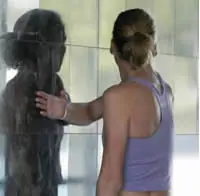I think of swimming as the savior for the triathlete. Swimming is the perfect compensator for biking and running.
In fact, the breathing, rhythm and extension in swimming are an invaluable counter movement or counter position to biking and running. If an athlete can't swim, they lose a lot more than just speed in the water.
Swimming will stretch tight quads from biking and strengthen the back for running. Yet it's the shoulder that's essential for swimming longevity. Use these stretches to take care of your shoulders and swim forever.
These stretches aid the shoulder girdle and the side of the torso, and will decrease compression, support range of motion and strengthen the torso. More specifically, we'll access the powerful pectorals (pects), versatile deltoids, valuable rotator cuff muscles, elastic latissimus dorsi (lats) and the underrated intercostal (rib) muscles.
You'll find that slight shoulder or hip rotation can modify the intensity of the stretch, or target a different area. Also, when you stay in a stretch, breathe deeply and compare the difference in the stretch at the top of the inhale versus the end of the exhale.
Front of the Shoulder Stretch: Pector Elongator
Maintaining open, fluid movement in the front of the shoulder during swimming will decrease compression in the joint. With biking and running, the shoulder tends to rotate inward and lift up toward the ear.
This same movement in swimming will add to tension and compression in the neck and shoulder.
The pector elongator is a great stretch to use before or after a workout.
- Stand with your right hip about two or three feet away from a wall.
- Place your right hand on the wall at shoulder level, behind the torso. Keep your elbow loosely bent.
- Now rotate your elbow forward and maintain this forward rotation throughout the stretch.
- Twist your upper torso to the left, while retaining elbow rotation, to create a stretch in the front of the right shoulder.
- Hold the stretch for five to 12 breaths.
- Switch arms and repeat.
Variations can be created by moving your hand up and down the wall or by stepping farther away from the wall. Pector elongator is intense, so go easy. When you start to feel the stretch, stop and inhale deeply into the area being stretched.
Also, using a doorway will give you a perfect stretch at home or at the office. The hard part of this stretch is continuing to maintain a forward rotation of the elbow.
Deltoid/Rotator Cuff Stretch
Every shoulder problem seems to have rotator cuff involvement. These muscles are unique because they function as a ligament at the joint, and a muscle in locomotion. Located above the rotators are the deltoids, which can be stretched along with the rotators.

When an athlete has any type of shoulder problem, this is the first stretch I introduce. It's ideal because it takes care of the muscle, the joint capsule and the range of motion.
- Stand facing the wall, approximately a foot away.
- Draw your right arm across your body.
- Place the back of your right hand on the wall at shoulder level.
- Move your left shoulder toward your right hand as far as you can, then lean the right shoulder toward the wall.
- To create a slightly different stretch, place the front of your hand on the wall.
- Hold the stretch for five to 12 breaths.
- Switch arms and repeat.


